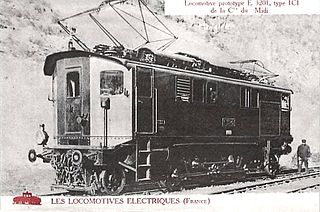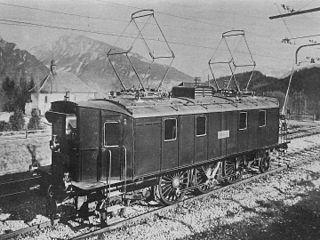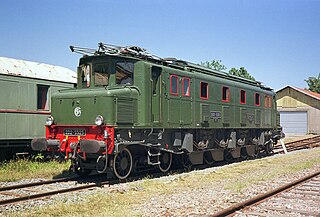
The Chemins de fer de Paris à Orléans et du Midi, often abbreviated to PO-Midi, was an early French railway company that was formed in 1934 following the merger of the Chemin de fer de Paris à Orléans and the Chemins de fer du Midi.

The Compagnie des chemins de fer du Midi, also known in English as the Midi or Southern Railway, was an early French railway company which operated a network of routes in the southwest of the country, chiefly in the area between its main line – which ran from Bordeaux, close to the Atlantic coast, to Sète on the Mediterranean – and the Pyrenees.

Steeplecab is railroad terminology for a style or design of electric locomotive; the term is rarely if ever used for other forms of power. The name originated in North America and has been used in Britain as well.

État 42-001 to 42-020, was a class of 2-8-2 Tank locomotives of the Chemins de Fer de l'État.

The BB 1 to 80 are electric locomotives of the former Paris-Orléans company, taken over by the SNCF at its creation in 1938.
The SNCF locomotives BB 101 to BB 180 were a class of 1500 V DC 4-axle electric locomotives originally built for the Chemin de fer de Paris à Orléans in the 1920s. The class were built as part of an order for 200 locomotives of similar types and were initially used on the newly electrified Paris - Vierzon line before being displaced by the SNCF 2D2 5500 class.

The SNCF locomotives BB 201 to BB 220 were a class of 1500 V DC 4-axle electric locomotives originally built for the Chemin de fer de Paris à Orléans in the 1920s.
The SNCF locomotives BB 1321 to BB 1324 were a class of 1500 V DC 4 axle electric locomotives originally built for the Chemin de fer de Paris à Orléans in the 1920s.
The SNCF locomotives BB 1425 to BB 1440 were a class of 1500 V DC 4 axle electric locomotives originally built for the Chemin de fer de Paris à Orléans in the 1920s.

The SNCF BB 1280 class were a class of 600 V DC 4 axle Bo′Bo′ electric locomotives, formerly Compagnie du chemin de fer de Paris à Orléans machines, initially built for an underground section of line connecting the Gare d'Austerlitz to the Quai d'Orsay in inner Paris. The locomotives were converted for 1500 V DC use in the 1930s, and renumbered PO E.281 to E.293. They were absorbed by the SNCF, and operated as shunters until the late 1960s.

The 2BB2 400 class were two electric locomotives built in 1926 for the Paris Orléans (PO) railway of France.

The SNCF CC 40100 was a French class of quad-voltage 4,340 kW (5,820 hp) electric locomotives. They were intended for high-performance passenger services on the Trans Europ Express (TEE) routes of the 1960s and 1970s. This non-stop international working required them to support the electrical standards of several networks. They are significant for combining three innovations in locomotive design: quad-voltage working, three-axle monomotor bogies and the new 'Nez Cassé' body style of French locomotives.

The BB 13000 class were electric locomotives operated by SNCF in France. They were one of four classes, together with the BB 12000, CC 14000 and CC 14100 classes, that formed an experimental group for studying the practicality of the new French 25 kV 50 Hz AC electrification.

1C1 3900 was a class of SNCF electric locomotive. The class had only one member, 1C1 3901. It was built in 1912 for the Chemins de fer du Midi and its Midi class was E 3200. It was one of six different prototype electric locomotives ordered by the Midi. It was withdrawn in 1959 and one motor from it is preserved.

Midi E 3301 was a prototype electric locomotive of Class E 3300 designed for the Chemins de fer du Midi, France. Because of poor performance, it was refused by the Compagnie du Midi and was re-deployed to Swiss railways. On 1 May 1919, it was classified Fb 2/5 11001 and, in 1920, it became experimental locomotive Be 2/5 11001 of the Swiss Federal Railways (SBB).

The Class CC 14000 were electric locomotives operated by SNCF in France. They were one of four classes, together with the BB 12000, BB 13000 and CC 14100 classes, that formed an experimental group for studying the practicality of the new French 25 kV 50 Hz AC electrification. It was used in freight service along the Lille – Thionville line. They were nicknamed Fer à repasser.

The 2D2 5500 were electric locomotives operated by the Compagnie du chemin de fer de Paris à Orléans, then SNCF in France, in operation from 1933 to 1980.
The Type 032 T is a class of steam locomotives, first used on the Chemins de fer du Midi, that were still in service when the SNCF was founded. The units had several designations during their careers.

The BB 20100 was a small class of two groups of two dual voltage electric locomotives of SNCF intended for cross-border traffic between France, Switzerland and Germany.

The SNCF Class BB 1600 were a class of 1,500 V DC electric locomotives built for the Pau – Lourdes line of the Chemins de fer du Midi by CEF. Numbered E 4001 to E 4050 at Midi, they became BB 4500 – B4550 when SNCF was created, then were relegated to shunting duties under the numbers BB 1601 to BB 1650 in the 1950s.
















